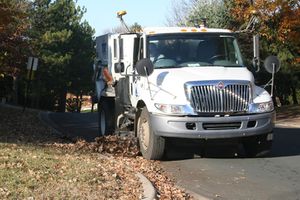
Difference between revisions of "Street sweeping"
m () |
|||
| Line 17: | Line 17: | ||
*[[Methods for sampling street sweeping material - Standard Operating Procedures]] | *[[Methods for sampling street sweeping material - Standard Operating Procedures]] | ||
*[[Methods for calculating pollutant reductions (credits) for street sweeping]] | *[[Methods for calculating pollutant reductions (credits) for street sweeping]] | ||
| + | *[[Accounting for phosphorus load reductions with street sweeping]] | ||
*[[P8 Street Sweeping Modeling]] | *[[P8 Street Sweeping Modeling]] | ||
*[[Guidance for incorporating street sweeping into the Minimal Impact Design Standards Calculator and MPCA’s Simple Estimator]] - '''Coming in summer, 2021''' | *[[Guidance for incorporating street sweeping into the Minimal Impact Design Standards Calculator and MPCA’s Simple Estimator]] - '''Coming in summer, 2021''' | ||
Revision as of 15:51, 23 March 2021
Contents
Information on street sweeping
- Overview of street sweeping
- Recommended street sweeping practices for water quality purposes - Coming in summer, 2021
- Pollutant removal associated with street sweeping
- Managing street sweepings
- Case studies for street sweeping
- Supporting information
Street sweeping crediting and Phosphorus Calculator
- Street Sweeping Phosphorus Credit Calculator - Coming in spring, 2021
- Street Sweeping Phosphorus Credit Calculator: User Guide
- Methods for sampling street sweeping material - Standard Operating Procedures
- Methods for calculating pollutant reductions (credits) for street sweeping
- Accounting for phosphorus load reductions with street sweeping
- P8 Street Sweeping Modeling
- Guidance for incorporating street sweeping into the Minimal Impact Design Standards Calculator and MPCA’s Simple Estimator - Coming in summer, 2021
University of Minnesota research on street sweeping
- Developing a street sweeping credit for stormwater phosphorus source reduction - this page contains information and the final report from the U of M study that led to development of the phosphorus calculator. Researchers: Sarah E. Hobbie, Rachel King, Tessa Belo, Lawrence A. Baker, Jacques C. Finlay.
- Quantifying Nutrient Removal through Targeted Intensive Street Sweeping - summary of Prior Lake study, 2010-2013 (Kalinosky et al., 2013). For additional information related to this project, link here
Links
- Internal
- External
- Using leaf collection and street cleaning to reduce nutrients in urban stormwater - This page summarizes on-going research by the United States Geological Survey on street sweeping. Lead researcher - William Selbig.
- Recommendations of the Expert Panel to Define Removal Rates for Street and Storm Drain Cleaning Practices - Final document produced by Chesapeake Bay expert panel
- Neat websites and articles for trees
Survey of street sweeping practices
The MPCA conducted a survey of cities to determine their street sweeping practices, their interest in a street sweeping credit, and their ability to implement different methods for crediting sweeping. We have not yet fully analyzed the data, but some general conclusions include the following.
- 75 cities responded to the survey and indicated they operate a sweeping program. This was a response rate of close to 50 percent. The responses were distributed geographically across the state and covered a wide range of city sizes (large to small).
- About 78 percent indicated they would be likely to participate in a crediting program
- All but 7 cities can track sweeping information, but 66 percent said they cannot relate material collected to a specific geographic area. This is a question we likely will follow-up with, since being able to relate material to a geographic location is potentially a way of targeting sweeping efforts.
- Most cities estimate volume or mass of material collected, but few measure volume or mass or have the ability to measure dry weight of material collected
- Most cities sweep quarterly or less and most do not specifically sweep in response to fall leave drop
The summary information can be found here.
Related pages
- Trees
- Phosphorus
- Total Suspended Solids (TSS) in stormwater
- Street sweeping for trees
- Neat websites and articles for trees
- Guidance for managing sediment and wastes collected by pretreatment practices: Note - this page contains some information on disposal of material collected in pretreatment practices, include information on street sweepings
